| Reviews & Columns |
|
Reviews DVD TV on DVD Blu-ray 4K UHD International DVDs In Theaters Reviews by Studio Video Games Features Collector Series DVDs Easter Egg Database Interviews DVD Talk Radio Feature Articles Columns Anime Talk DVD Savant Horror DVDs The M.O.D. Squad Art House HD Talk Silent DVD
|
DVD Talk Forum |
|
|
| Resources |
|
DVD Price Search Customer Service #'s RCE Info Links |
|
Columns
|
|
|
Dietrich and von Sternberg in Hollywood - The Criterion Collection
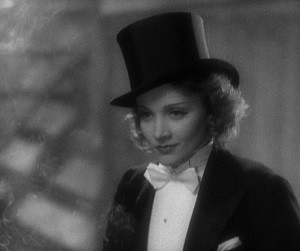 In 1930, director Josef von Sternberg helmed The Blue Angel, the first full-length "talkie" in German film history. The star of the film was Emil Jannings, making his sound debut, but the most important relationship formed on the production was between von Sternberg and then-unknown Marlene Dietrich, who von Sternberg cast in the role of Lola Lola despite having already signed actress Kathe Haack for the role. Although The Blue Angel would not be released in America until 1931, von Sternberg left Germany for Hollywood after completing it and insisted that Paramount sign Dietrich to a contract, kicking off the string of films comprising Criterion's new six-film Blu-ray box set, Dietrich & von Sternberg in Hollywood.
In 1930, director Josef von Sternberg helmed The Blue Angel, the first full-length "talkie" in German film history. The star of the film was Emil Jannings, making his sound debut, but the most important relationship formed on the production was between von Sternberg and then-unknown Marlene Dietrich, who von Sternberg cast in the role of Lola Lola despite having already signed actress Kathe Haack for the role. Although The Blue Angel would not be released in America until 1931, von Sternberg left Germany for Hollywood after completing it and insisted that Paramount sign Dietrich to a contract, kicking off the string of films comprising Criterion's new six-film Blu-ray box set, Dietrich & von Sternberg in Hollywood.
Throughout the six films in the set -- Morocco (1930), Dishonored (1931), Shanghai Express (1932), Blonde Venus (1932), The Scarlet Empress (1934) and The Devil is a Woman (1935) -- von Sternberg and Dietrich show off their range, covering melodrama, tragedy, thrills, a touch of comedy, and plenty of romance (almost every one finds Dietrich with multiple suitors). Crediting von Sternberg alone with the "creation" of Dietrich's image arguably undermines her talents, but it's safe to say that their works leave both of them looking good, as Dietrich gamely meets each one of von Sternberg's new challenges, and von Sternberg's vision becomes increasingly elaborate.
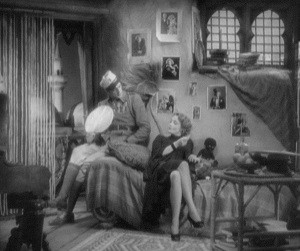 The first, and in some ways, most historically notable of their collaborations is Morocco, which scored Academy Award nominations for both von Sternberg and Dietrich, and was inducted into the National Film Registry in 1992. It also features what might be the first kiss between two women in cinema history, between Dietrich and a patron of the cabaret where her character Amy Jolly works (although, within the film, it's merely a display of stage bravado rather than a genuinely queer moment). The film follows Jolly and her romance with a Foreign Legion soldier named Tom Brown (Gary Cooper), despite Brown's lack of self-confidence and unwillingness to commit to her. While Brown becomes entangled in an infidelity plot and wrestles with his commitment to the Legionnaires, rich local La Bessiere (Adolphe Menjou) makes his move to win Amy's hand in marriage, despite her evident disinterest.
The first, and in some ways, most historically notable of their collaborations is Morocco, which scored Academy Award nominations for both von Sternberg and Dietrich, and was inducted into the National Film Registry in 1992. It also features what might be the first kiss between two women in cinema history, between Dietrich and a patron of the cabaret where her character Amy Jolly works (although, within the film, it's merely a display of stage bravado rather than a genuinely queer moment). The film follows Jolly and her romance with a Foreign Legion soldier named Tom Brown (Gary Cooper), despite Brown's lack of self-confidence and unwillingness to commit to her. While Brown becomes entangled in an infidelity plot and wrestles with his commitment to the Legionnaires, rich local La Bessiere (Adolphe Menjou) makes his move to win Amy's hand in marriage, despite her evident disinterest.
Having gone through the entire set, Morocco offers up the first of what turns out to be a series of bad-to-mediocre lovers for Dietrich's characters. Brown is kind of a jerk, acting belligerent and rude toward Amy at first. On the other hand, there's not much to see in La Bessiere, either: Amy states upfront that she feels the rich are boring, and La Bessiere bears that theory out with stuffy dinner parties and little in the way of personality. Although the story seems to lose focus on her in favor of details about Brown's infidelity and a blackmail scheme, Dietrich is compelling in the lead role both musically and dramatically, and von Sternberg shows off his skill at filling in the vast desert outside of the 4:3 frame. The film builds to a conclusion that may feel dissatisfying to viewers, but there's no indication that von Sternberg intended the movie to have a happy ending -- just one befitting the characters.
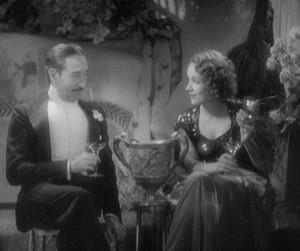 If Dietrich and her beau weren't exactly the perfect couple in Morocco, she and von Sternberg double down with Dishonored, in which Dietrich's Marie Kolverer is recruited as a spy for the Austrians under the code name X-27. A widow who has taken up sex work after the death of her husband, von Sternberg and Dietrich explore how the perception of the men around her clashes with who she actually is. The dischord peaks when she meets her match, a Russian colonel named Kranau (Victor McLaglen). Despite her genuine desire to help Austria, she is attracted to Kranau, kicking off a sexual cat-and-mouse game between them where neither really wants the other player to lose.
If Dietrich and her beau weren't exactly the perfect couple in Morocco, she and von Sternberg double down with Dishonored, in which Dietrich's Marie Kolverer is recruited as a spy for the Austrians under the code name X-27. A widow who has taken up sex work after the death of her husband, von Sternberg and Dietrich explore how the perception of the men around her clashes with who she actually is. The dischord peaks when she meets her match, a Russian colonel named Kranau (Victor McLaglen). Despite her genuine desire to help Austria, she is attracted to Kranau, kicking off a sexual cat-and-mouse game between them where neither really wants the other player to lose.
von Sternberg's use of shadows is a trademark, and Dishonored contains the most striking shadow imagery of any of the six films in the set: spies from both sides lurking in darkness, including a pivotal confrontation where McLaglen is a pitch-black silhouette; the faint shadow of gun barrels landing on the surface of a drum being played. The film also employs masks as a device, at a masquerade party where Dietrich's dazzling grin peeks out from beneath a black mask. There is also a sequence where Dietrich's character poses as a lowly maid, which is striking both as a convincing visual transformation with minimal makeup and hair changes, and also as a particularly deft bit of work by Dietrich (and mostly silent, to boot). von Sternberg further employs lingering crossfades that suggest memory or emotion, and the film's use of music (piano is a skill of Marie's) is just plain cool -- at one point, a secret message is translated into sheet music.
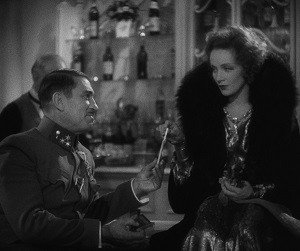 When Kranau first confronts Marie about being a spy, he dismisses her work as something that doesn't belong on the battlefield, as if using her feminine wiles is somehow cheating. The idea that women are villainous for manipulating men rather than men being at fault for falling for it (no matter how obvious) will crop up again in The Devil is a Woman and Blonde Venus, and von Sternberg's approach feels neutral, allowing the audience to draw their own conclusions about Marie's supposed villainy. Like Morocco, it doesn't really matter whether or not the audience likes or invests in the romance between Marie and Kranau (whose persistent, strained grin is unsettling and uncomfortable), just whether or not they believe, through Dietrich's performance, that the character is acting consistently (not to mention, both characters openly state that they're not afraid of death). Through Marie's unwavering determination, von Sternberg raises the film's anti-war message, where the natural connection between two human beings can be a fatal mistake when the countries are at war, even if Marie's commitment to Austria is never in question.
When Kranau first confronts Marie about being a spy, he dismisses her work as something that doesn't belong on the battlefield, as if using her feminine wiles is somehow cheating. The idea that women are villainous for manipulating men rather than men being at fault for falling for it (no matter how obvious) will crop up again in The Devil is a Woman and Blonde Venus, and von Sternberg's approach feels neutral, allowing the audience to draw their own conclusions about Marie's supposed villainy. Like Morocco, it doesn't really matter whether or not the audience likes or invests in the romance between Marie and Kranau (whose persistent, strained grin is unsettling and uncomfortable), just whether or not they believe, through Dietrich's performance, that the character is acting consistently (not to mention, both characters openly state that they're not afraid of death). Through Marie's unwavering determination, von Sternberg raises the film's anti-war message, where the natural connection between two human beings can be a fatal mistake when the countries are at war, even if Marie's commitment to Austria is never in question.
The duo's next film, Shanghai Express, takes "loyalty" and adjusts it to "faith." Onboard a Chinese train heading to Shanghai, Captain Donald Harvey (Clive Brook) runs into his old flame, Madeline (Dietrich), now well-known as the infamous sex worker "Shanghai Lily." Harvey despises her new profession and seems to resent the broken heart he's been nursing since she left, but their romantic history is forced to take a backseat when Henry Chang (Warner Oland, making a second appearance here following Dishonored, and who will be familiar to audiences as the white actor who shot to fame playing Fu Manchu and Charlie Chan) reveals himself to be the leader of a Chinese rebel army, forcing the train to stop before it reaches its destination. Harvey, a doctor, then finds himself a hostage as Chang attempts to use him as leverage against the Governor-General of Shanghai.
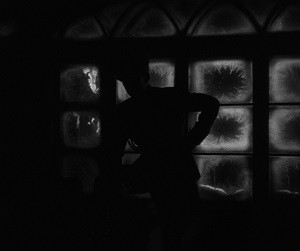 Shanghai Express is the only film in the set that qualifies as a full-blown ensemble, with the motley crew of fellow passengers (Lawrence Grant, Eugene Pallette, Louise Closser Hale, Emile Chautard, and Gustav von Seyffertitz) all filling well-defined supporting roles (a distinctly contemporary but pretty straightforward comparison would be the passengers on the bus in Speed). Above all of them is Chinese-American actress Anna May Wong, playing Madeline's fellow sex worker Hui Fei, whose character gets a real dramatic arc that feels non-stereotypical and well-develped, and Wong seems to relish the opportunity. The script, by Jules Furthman, adapted from an unpublished novel by Harry Hervey, is a well-crafted bit of chess that shifts the pieces around the board quickly but keeps the audience attentive to the dynamics of perspective between the characters.
Shanghai Express is the only film in the set that qualifies as a full-blown ensemble, with the motley crew of fellow passengers (Lawrence Grant, Eugene Pallette, Louise Closser Hale, Emile Chautard, and Gustav von Seyffertitz) all filling well-defined supporting roles (a distinctly contemporary but pretty straightforward comparison would be the passengers on the bus in Speed). Above all of them is Chinese-American actress Anna May Wong, playing Madeline's fellow sex worker Hui Fei, whose character gets a real dramatic arc that feels non-stereotypical and well-develped, and Wong seems to relish the opportunity. The script, by Jules Furthman, adapted from an unpublished novel by Harry Hervey, is a well-crafted bit of chess that shifts the pieces around the board quickly but keeps the audience attentive to the dynamics of perspective between the characters.
The relationship between Madeline and Harvey is another slightly rough one, with Harvey coming off as a bit of a sore loser, even if Madeline was responsible for the end of the relationship (his demeaning view of how she's changed since he last saw her doesn't help, either). At the same time, the arc of Dietrich's Madeline, especially the way it intersects with Grant's character, a Christian missionary named Mr. Carmichael who initially seems to despise everyone, is compelling enough to get the movie over any rough patches. A bittersweet ending might've fit Brook's performance as Harvey a little better -- it could be argued that his Harvey lacks the faith that Madeline ultimately discovers -- but the movie is a sharp, streamlined winner.
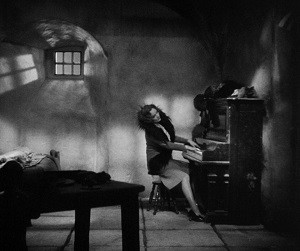 In some ways, Blonde Venus feels like an overhauled Morocco. Once again, Dietrich plays a cabaret performer, Helen Faraday, who is retired and married to Ned Faraday (Herbert Marshall). They have a young child, Johnny (Dickie Moore), and Ned is on the cusp of completing a formula that will ease all financial woes. The only problem is that Edward is also dying of radium poisioning, and doesn't have much time before he will succumb to the disease. To get the $1,500 that Ned needs to get overseas for a groundbreaking new treatment, Helen returns to the stage (despite Ned's reluctance), but instead of working for the money, she finds herself in the good graces of a rich politician named Nick Townsend (Cary Grant). Ned departs for the UK, prompting Nick to shower Helen with favors and intimate time together. When Ned, freshly cured, returns home and gets the impression that Helen has been unfaithful, Helen goes on the run with Johnny in tow to escape Ned's bitter desire for sole custody.
In some ways, Blonde Venus feels like an overhauled Morocco. Once again, Dietrich plays a cabaret performer, Helen Faraday, who is retired and married to Ned Faraday (Herbert Marshall). They have a young child, Johnny (Dickie Moore), and Ned is on the cusp of completing a formula that will ease all financial woes. The only problem is that Edward is also dying of radium poisioning, and doesn't have much time before he will succumb to the disease. To get the $1,500 that Ned needs to get overseas for a groundbreaking new treatment, Helen returns to the stage (despite Ned's reluctance), but instead of working for the money, she finds herself in the good graces of a rich politician named Nick Townsend (Cary Grant). Ned departs for the UK, prompting Nick to shower Helen with favors and intimate time together. When Ned, freshly cured, returns home and gets the impression that Helen has been unfaithful, Helen goes on the run with Johnny in tow to escape Ned's bitter desire for sole custody.
Throughout all of von Sternberg and Dietrich's collaborations, there is a low-key streak of feminism. Some of this is merely by virtue of the fact that Dietrich plays characters that don't compromise under pressure (including the ones whose values aren't necessarily wholesome), whereas others, like Blonde Venus, end up feeling feminist merely because they appear clear-eyed about men's selfishness and shortcomings. Bizarrely, the second half of Venus comes off like a striking premonition of 21st century "men's rights activists," who have a bizarre obsession with child custody as a supposedly sexist system. In the film, at least, there's no question that Helen has Johnny's best interests at heart, even as they're on the lam (it may not be great to put a kid in the position of evading cops, but she's certainly not mistreating Johnny, nor is there any question that she loves him deeply). However, as Ned's police report travels the country, von Sternberg depicts a subtle sense of solidarity between the other men who view Helen as a monster who's robbed poor Ned of his beloved son, sneering as they pick up phones to send in tips to investigators. The one cabaret owner shown as sympathetic to Helen's plight is another woman.
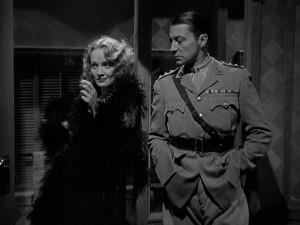 Although it can be argued that Helen's time spent with Nick is a form of emotional infidelity -- she has no illusions about the fact that he's attracted to her -- both Nick and Ned seem more compelled by the power struggle than whether or not she actually cares for them. In von Sternberg's eyes and in terms of Dietrich's performance, there's no question she loves Ned and merely views Nick as means to an end. It's easier to suspect Nick of bad motives, a man who clearly gets a manipulative thrill out of using his means to solve people's problems, but it feels pointed that even Ned gets his first date with Helen when he and his friends stumble across her and the rest of her cabaret troupe bathing naked in a stream and refuse to leave unless they promise to meet after their show. The next thing we see is Helen and Ned, happily married, with Johnny -- and the strong implication that Ned forced her to leave the theatre. Unsurprisingly, the film only tracks this up to a certain point, angling toward a less bitter resolution. Battles with the Hays Code apparently altered the script so much that neither von Sternberg or Dietrich liked the finished product, but it's hard to look at the film and feel it isn't a bit prescient.
Although it can be argued that Helen's time spent with Nick is a form of emotional infidelity -- she has no illusions about the fact that he's attracted to her -- both Nick and Ned seem more compelled by the power struggle than whether or not she actually cares for them. In von Sternberg's eyes and in terms of Dietrich's performance, there's no question she loves Ned and merely views Nick as means to an end. It's easier to suspect Nick of bad motives, a man who clearly gets a manipulative thrill out of using his means to solve people's problems, but it feels pointed that even Ned gets his first date with Helen when he and his friends stumble across her and the rest of her cabaret troupe bathing naked in a stream and refuse to leave unless they promise to meet after their show. The next thing we see is Helen and Ned, happily married, with Johnny -- and the strong implication that Ned forced her to leave the theatre. Unsurprisingly, the film only tracks this up to a certain point, angling toward a less bitter resolution. Battles with the Hays Code apparently altered the script so much that neither von Sternberg or Dietrich liked the finished product, but it's hard to look at the film and feel it isn't a bit prescient.
The second-to-last film in the set is the best of the lot, encapsulating both Dietrich's range as a performer and von Sternberg's ambition as a filmmaker. The Scarlet Empress casts the star as Sophia Frederica, the woman who would later be known as Catherine the Great, as she is plucked from Germany and transplanted to Russia, where she is to marry Grand Duke Peter (Sam Jaffe), the presumptive heir to the Russian throne. Count Alexei (John Davis Lodge), the envoy sent by Peter to pick Sophia up and bring her to Moscow, informs her that Peter is handsome and smart, but upon arrival, it becomes clear that Empress Elizabeth (Louise Dresser) is the true power behind the throne, and that Peter is a creep who loathes Elizabeth and is repulsive to Sophia. As Sophia becomes Catherine, adjusting to her new life, she goes from a wide-eyed child to a sexually aggressive manipulator with her own plans for Peter, following in Elizabeth's spiritual footsteps even as she disrupts Elizabeth's plans for her.
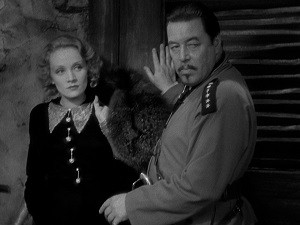 The Scarlet Empress is an epic, yet it is an epic with a small cast of key characters, an epic that contains battle sequences only in montage, spanning multiple countries but largely taking place in a single elaborate palace. von Sternberg utilizes a number of techniques to craft his vision, including miniatures and matte paintings of the German and Russian landscapes. The palace is an unforgettable bit of production design, with massive 20-foot-tall doors and secret passages, and every room filled with slightly grotesque statues grasping candles. Even in the relatively small space of the 4:3 frame, von Sternberg uses slow pans to help underline the scope of his setting, moving methodically up a lengthy banquet table before pulling back to show the massive crowd of people around it, or following Dietrich down a staircase and into a room where she methodically kisses a row of people on the hand. The space is at once cavernous and claustrophobic, with Sophia/Catherine clearly yearning to escape the oppressive people found within it. The massive scope of the production would ultimately prove a problem at the box office, with the disaster essentially laying the groundwork for the end of von Sternberg and Dietrich's professional relationship, but viewed as a work of art, von Sternberg's finished product is extraordinary.
The Scarlet Empress is an epic, yet it is an epic with a small cast of key characters, an epic that contains battle sequences only in montage, spanning multiple countries but largely taking place in a single elaborate palace. von Sternberg utilizes a number of techniques to craft his vision, including miniatures and matte paintings of the German and Russian landscapes. The palace is an unforgettable bit of production design, with massive 20-foot-tall doors and secret passages, and every room filled with slightly grotesque statues grasping candles. Even in the relatively small space of the 4:3 frame, von Sternberg uses slow pans to help underline the scope of his setting, moving methodically up a lengthy banquet table before pulling back to show the massive crowd of people around it, or following Dietrich down a staircase and into a room where she methodically kisses a row of people on the hand. The space is at once cavernous and claustrophobic, with Sophia/Catherine clearly yearning to escape the oppressive people found within it. The massive scope of the production would ultimately prove a problem at the box office, with the disaster essentially laying the groundwork for the end of von Sternberg and Dietrich's professional relationship, but viewed as a work of art, von Sternberg's finished product is extraordinary.
Although all of Dietrich's characters display a certain committment to their personal principles, the characters in each of the six films feel distinct and different from one another, establishing her skill as a performer. Although many of those characters have arcs, none are as pronounced as her transformation from Sophia to Catherine. Until one actually witnesses it, it's hard to imagine Dietrich every playing a completely guileless person, but she throws herself equally into the youthful innocence of Sophia and the man-eating seductiveness of Catherine. The performance also contains some of Dietrich's best touches. In one incredible moment, she reacts to a threat without a single word. The other performances are largely split as well, with Jaffe's Peter going from a pathetic creep to an unhinged tyrant as Dresser's commanding Elizabeth succumbs to a fatal illness. Even Alexei, who is the most consistent, finds the balance of power in his pursuit of Sophia shifted when she becomes Catherine. Early on, she is afraid that giving into his affections will get her into trouble; later, she views his affections as pathetic and enacts a bit of revenge for his lie about her future beau.
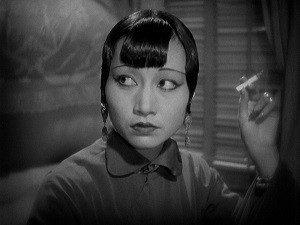 The set concludes with a bit of a comedown, both in scope and dramatic satisfaction, but still a worthwhile film in its own right (and reportedly Dietrich's favorite of her collaborations with von Sternberg). The Devil is a Woman, surprisingly, almost backgrounds Dietrich in a way, spending almost half of the runtime on a flashback in which former police captain Pasqual (Lionel Atwill) tries to warn his friend Antonio (Cesar Romero), a handsome young outlaw, away from the beautiful Concha Perez (Dietrich). Although Dietrich, of course, appears in Pasqual's story, von Sternberg roots these scenes so firmly in Pasqual's perspective that it doesn't feel as if Concha is present in the picture until Pasqual and Antonio part and the plot begins to move forward. Pasqual's story outlines Concha's repeated manipulation of his affection for her to get what she wants, largely centered around money for her family or other kinds of help only Pasqual can afford.
The set concludes with a bit of a comedown, both in scope and dramatic satisfaction, but still a worthwhile film in its own right (and reportedly Dietrich's favorite of her collaborations with von Sternberg). The Devil is a Woman, surprisingly, almost backgrounds Dietrich in a way, spending almost half of the runtime on a flashback in which former police captain Pasqual (Lionel Atwill) tries to warn his friend Antonio (Cesar Romero), a handsome young outlaw, away from the beautiful Concha Perez (Dietrich). Although Dietrich, of course, appears in Pasqual's story, von Sternberg roots these scenes so firmly in Pasqual's perspective that it doesn't feel as if Concha is present in the picture until Pasqual and Antonio part and the plot begins to move forward. Pasqual's story outlines Concha's repeated manipulation of his affection for her to get what she wants, largely centered around money for her family or other kinds of help only Pasqual can afford.
Like Dishonored, von Sternberg presents Concha's manipulation as a matter of fact, offering no judgment of her behavior. As Pasqual's story continues, as he becomes fooled again and again, one quickly starts to feel less critical of Concha and more embarrassed on Pasqual's behalf -- how many times can he trick himself into believing her? Dietrich's performance is also the closest she gets in any of these films to outright comedy, playing Concha as a shameless vamp who never stops working every mark in the room. Of course, Pasqual's story also comes to a jarring, bittersweet conclusion when he finally gets revenge through physical abuse, another example of von Sternberg's objective perspective arguably allowing for a feminist reading. The violence doesn't appear to faze Concha, who doesn't change her game one bit.
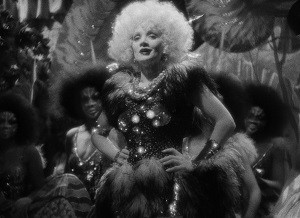 The film is performed well by all involved, especially Atwell, whose dedication to Concha forms the backbone of the drama. At the same time, it's hard to look at a simple love triangle as a step back following the grandeur of Scarlet Empress, with a lengthy chunk of the film spent on Atwell and Romero simply sitting in a basic cafe. It's also somewhat ironic that after several of the preceding films in the set contrive relatively happy endings, The Devil is a Woman goes ambiguous and bittersweet when it feels like the story calls out for a more positive resolution.
The film is performed well by all involved, especially Atwell, whose dedication to Concha forms the backbone of the drama. At the same time, it's hard to look at a simple love triangle as a step back following the grandeur of Scarlet Empress, with a lengthy chunk of the film spent on Atwell and Romero simply sitting in a basic cafe. It's also somewhat ironic that after several of the preceding films in the set contrive relatively happy endings, The Devil is a Woman goes ambiguous and bittersweet when it feels like the story calls out for a more positive resolution.
Throughout all of the films, Dietrich is an incredible screen presence, decked out in incredible costumes. Veils, gowns, suits, dresses, headpieces, and more, many of which are covered in jewels -- the white suit with diamond-crusted lapels she wears in Blonde Venus is especially striking. Meanwhile, von Sternberg blesses her with intense close-ups and incredible musical numbers that help showcase her incredible talent, while also reminding the viewer of his own skill managing the cinematography, production design, and staging of the films. At the end of Dishonored, her character laments, "I suppose I'm not much good, that's all." As Criterion's lavish box set proves, that's not true of Dietrich or von Sternberg at all.
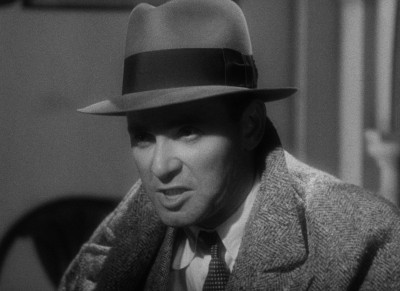 The Blu-ray
The Blu-ray
Dietrich & von Sternberg in Hollywood arrives in a thick black-and-white slipbox, which houses individual cardboard trays for each of the six movies, plus the set's hefty booklet, which runs a whopping 80 pages and features essays by Gary Giddens, Farran Smith Nehme, and Imogen Sarah Smith, plus the usual crop of Criterion cast lists, technical specs, and acknowledgements. Both the cover of the set and the booklet are adorned with amusing photos of Dietrich and von Sternberg together, presumably captured during downtime on one of their collaborations, and each individual digipak features a picture of Dietrich from the film in question. The back covers for both the outer slipbox and individual cardboard cases are all text, with summaries for the films and extras, and on the inside flap next to the disc, there is a still from each film. The only color on the set is a coppery brown, vaguely akin to a sepia accent, which adds to the "vintage" flavor of the set.
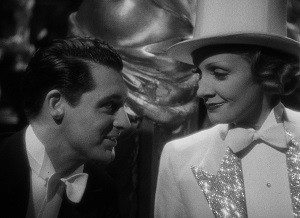 The Video and Audio
The Video and Audio
All six films in Dietrich & von Sternberg in Hollywood have been given new scans under Criterion's supervision, with Morocco having been done at 2K and the rest at 4K. Based on the text in the accompanying booklet, none of the films were restored from the original negative; instead, fine-grain safety prints, 35mm prints, and one dupe negative were utilized, most of which were sourced from the UCLA Film and Television Archives. As is to be expected, minor frame jumps, vertical lines, density fluctuation, and the occasional hair crop up here and there, and the overall condition of the source elements used varies slightly. However, all six of the films look excellent in high definition, capturing the opulent decadance of Dietrich's various elaborate costumes and von Sternberg's frequently imposing production design. The grain occasionally has a slightly unusual texture, but it's likely that this is a byproduct of having to be sourced from alternatives to the original camera negatives. Closer inspection reveals a little of what I imagine many feel are shortcomings with Criterion's compression, but on the whole, it's unlikely to bother viewers aside from the especially picky or those with incredibly large screens. Although The Scarlet Empress may be the most impressive of the restorations, and the somewhat hazy Morocco might be the least impressive (due to age, not the work involved), the set is consistent enough for it to be largely inconsequential to rank the individual transfers as opposed to the work as a whole, which is very strong based on the elements available.
Sound for all six features is DTS-HD Master Audio 1.0 mono. As one might expect, there is the occasional age-related fuzziness to some of the dialogue and music, but on the whole these are more than adequate, and again the work is essentially consistent across the board. English captions for the deaf and hard of hearing are also included on all of the films.
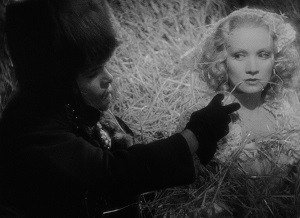 The Extras
The Extras
There is no dedicated extras disc for Dietrich & Von Sternberg in Hollywood, so the extras will be broken down based on the film disc they appear on.
Morocco:
Three video extras are included on the disc for Morocco. The first one is a general piece, "Weimar on the Pacific" (29:10), which finds scholars Gerd Gemunden and Noah Isenberg diving into Marlene Dietrich's journey specifically through the lens of someone who immigrated from Germany to Hollywood. The featurette includes vintage footage, including Dietrich's first screen test for von Sternberg, as well as a number of photos which both scholars discuss at length, delving into the various stories of how she was discovered and how much the director contributed to her image as a movie star. They also touch on her bisexuality and her comfort with genderfluidity that stemmed from the culture in Weimar, and how she became a controversial figure in Germany thanks to the fact that she was in America during the rise of Hitler. Naturally, the featurette covers a couple of films outside of the set, including The Blue Angel, and Billy Wilder's A Foreign Affair.
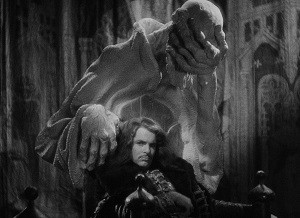 The other two new extras are film-specific. First, there is an interview with film scholar Janet Bergman (31:09) on the making of Morocco (note: although the menu text says the featurette was produced in 2014, it does not appear to have been published before now). Bergman makes no secret, right from the beginning, of her love for Morocco, and the piece is buoyed by that personal emotional investment as she explores some of the same history covered by the previous featurette and then gets into the film itself. This is almost akin to an audio commentary, with Bergman singling out individual lines of dialogue, shot compositions, and other very specific details that get at a specific reading of what Dietrich and von Sternberg were attempting to do with the picture. This is followed by "The Real Amy Jolly" (4:33), in which Sike Ronneburg of the Deutsche Kinemathek discusses the existence of a real Amy Jolly. Unbeknownst to Dietrich or von Sternberg, writer Benno Vigny had met Amy Jolly and promised to give her a cut of the profits when her story was sold, but failed to do so when his novel went unpublished. Ronneburg shows two letters, sent by Jolly to Dietrich, and the telegrams included within.
The other two new extras are film-specific. First, there is an interview with film scholar Janet Bergman (31:09) on the making of Morocco (note: although the menu text says the featurette was produced in 2014, it does not appear to have been published before now). Bergman makes no secret, right from the beginning, of her love for Morocco, and the piece is buoyed by that personal emotional investment as she explores some of the same history covered by the previous featurette and then gets into the film itself. This is almost akin to an audio commentary, with Bergman singling out individual lines of dialogue, shot compositions, and other very specific details that get at a specific reading of what Dietrich and von Sternberg were attempting to do with the picture. This is followed by "The Real Amy Jolly" (4:33), in which Sike Ronneburg of the Deutsche Kinemathek discusses the existence of a real Amy Jolly. Unbeknownst to Dietrich or von Sternberg, writer Benno Vigny had met Amy Jolly and promised to give her a cut of the profits when her story was sold, but failed to do so when his novel went unpublished. Ronneburg shows two letters, sent by Jolly to Dietrich, and the telegrams included within.
The disc wraps up with "The Legionnaire and the Lady," (59:09), a radio adaptation of Morocco starring Dietrich and Clark Gable, broadcast by the Lux Radio Theatre in 1936.
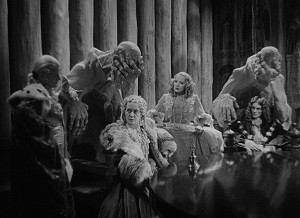 Dishonored:
Dishonored:
On the set's second disc, all of the extras are general-purpose. "Dietrich Icon" (20:23) is another exploration of Dietrich, this time through a feminist lens, with scholars Mary Desjardins, Amy Lawrence, and Patricia White, who talk about how Dietrich claimed her sexuality and crafted her image as a sex symbol. Although it's easy to notice that she never plays a victim, it's interesting for them to note that she never cries, either. The piece also, like the one on the previous disc, delves deep into her queerness, and her willingness to play with genderfluidity with costumes and small notes in her performances, and continues through into the post-von Sternberg period of her career. On the other hand, the Hays Code makes more of an appearance in this clip, including its affect on her movies, as does a discussion of Stand-In, a thinly-veiled shot at Dietrich and von Sternberg. Next, Cristina Alvarez Lopez and Adrian Martin have crafted a video essay entitled "Bodies and Spaces, Fabric and Light" (29:17), which examines von Sternberg's cinematography. The piece, which is not narrated by its creators, is simply an extremely impressive montage of clips from the six films in the set, accompanied by the occasional quote from film scholars (as well as the star and filmmaker themselves) about the theory of image composition that informs what the viewer should be considering in the footage that follows. This piece alone is a miniature masterclass on filmmaking technique, and is one of the best and most illuminating extras on the disc (expect to see it in various college film courses in the future). The disc wraps up with another Fiction Factory supplement: an interview with Josef's son Nicholas von Sternberg (14:50). Nicholas' love of photography was a direct result of his relationship with his father, and Nicholas talks at length at his father's lighting technique and how his style was influenced by painting, as well as von Sternberg's collaboration with various cinematographers, resulting in a surprisingly technical interview (albeit one peppered with personal memories and sentiment).
Shanghai Express:
Only one extra is included on the disc for Shanghai Express, an interview with author Homay King (23:07) on von Sternberg's portrayal of China in Shanghai Express. Personally, Shanghai Express strikes me as the most tightly-plotted of the films in the set, but right off the bat, Wong instead argues that the film is pure visual expression, that the plot is almost incidental to von Sternberg's traditional use of light and shadow. She discusses the film's largely fictionalized version of China, and the few areas in which the film taps into real-life political conflicts in a fractured China under the rule of various outside governments. She points out backgrounds, barely glimpsed outside the train, that were actually shot by famous cinematographer James Wong Howe, and the way that the needs of the story and von Sternberg's visuals sometimes betray the film's supposed setting. Finally, she delves into Anna May Wong, her history in Hollywood and abroad, and her relationship with Dietrich.
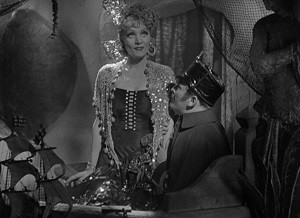 Blonde Venus:
Blonde Venus:
The disc for Blonde Venus contains three more pieces, two of which are new and all of which are general and not film-specific. First, "The Marlene Dietrich Collection" (14:43) brings back Sike Ronneburg of the Deutsche Kinemathek to talk about the collection she has curated of Dietrich memorabilia at the Kinemathek in Berlin. Dietrich's collection of her own memorabilia was one of the largest Sotheby's had ever received, and it was directed to the Kinemathek thanks to the intervention of Dietrich's daughter Maria Riva, who accepted their bid over a higher one that might've torn the collection apart. Even now, the museum is still archiving some of the material, given there was so much of it.
The other two are both costume-focused, specifically the work of Travis Banton, a close collaborator of Dietrich and von Sternberg. For the first, costume designer and director of UCLA's David C. Copley Center for the Study of Costume Design Deborah Nadoolman Landis sits down for a discussion (15:03) of Banton's work with the duo. Landis is a particularly joyous and enthusiastic interview subject, enthusing about Banton's history, and getting especially excited as she recounts her time working out of Banton's office and getting to marvel over the fabrics and pieces that he had left behind. She also delves into the method with which Banton would work with von Sternberg and Dietrich, and the piece includes a number of Banton's drawings. This is followed by a vintage 1935 short "The Fashion Side of Hollywood" (10:24), provided by the Deutsche Kinemathek, which features Banton in something akin to a sketch where he talks to a woman inquiring about costumes worn by various movie stars in Paramount movies. Dietrich is seen modeling a costume from The Devil is a Woman, among others, while some of the other stars appear either in modeling shots or in clips from the movies in question
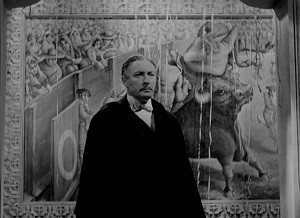 The Scarlet Empress:
The Scarlet Empress:
The last big extra in this set is a fun one. "Dietrich in Denmark" (28:27) is a 1971 television interview -- per the hosts, the first one she ever granted -- conducted for Swedish television. The piece quickly dives into her relationship with von Sternberg, talking about her early experiences in Hollywood, and what she thought von Sternberg contributed to her image. She also becomes especially animated in the second half of the interview, as they segue from her film career to her work at the time, touring and performing songs. This is a surprisingly low-key interview, with a true unrehearsed quality, and very fascinating to watch even if Dietrich is clearly exhibiting quite a bit of control over her own image that may be more the image she wants to craft than the absolute truth.
The Devil is a Woman:
Only one brief extra is included on the last disc: "If It Isn't Pain" (2:23), which was cut from the film due to its racy content by the Production Code Administration. Unsurprisingly, no footage of the number has survived; the supplement features the audio taken from a promotional vinyl over a still image.
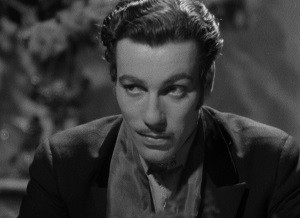 Conclusion
Conclusion
A Criterion edition of The Scarlet Empress might've been a worthy venture all by itself, but this box set collecting all six of their Hollywood pictures under contract at Paramount fills in a crucial context around Empress, showing the nuances and range of their professional collaboration. Each one of the films is striking and features an impressive turn by Dietrich, and each one has been granted a fresh presentation and new extras here that fans will be thrilled to dig into. Absolutely worthy of the DVDTalk Collector's Series.
Please check out my other DVDTalk DVD, Blu-ray and theatrical reviews and/or follow me on Twitter.
|
| Popular Reviews |
| Sponsored Links |
|
|
| Sponsored Links |
|
|
| Release List | Reviews | Shop | Newsletter | Forum | DVD Giveaways | Blu-Ray | Advertise |
|
Copyright 2024 DVDTalk.com All Rights Reserved. Legal Info, Privacy Policy, Terms of Use,
Manage Preferences,
Your Privacy Choices | |||||||












